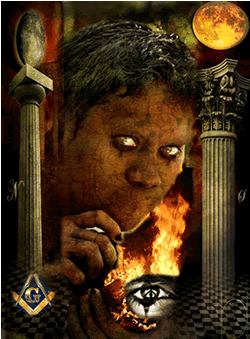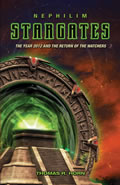READ
IT BEFORE IT'S BANNED BY THE US GOVERNMENT
PART 16
By Thomas R. Horn
July 28, 2009
NewsWithViews.com
THE COMING GODS OF THE NEW WORLD ORDER
"In
the E at Delphoi, although the sun represents God… Plutarch here
associates this supreme god with the Apollon of religion, while in the
essay on Isis religion, he is associated with Osiris. Both Apollo(n) and
Osiris are sun gods [who]… turns out to be (not to our surprise)
the Delphic Apollo (A- pollon)."—Frederick
E. Brank, Relighting the souls: studies in Plutarch, in Greek literature,
religion, and philosophy, and in the New Testament background.
pollon)."—Frederick
E. Brank, Relighting the souls: studies in Plutarch, in Greek literature,
religion, and philosophy, and in the New Testament background.
"The Solar Eye [on the Great Seal of the United States] was called the eye of… Apollo… the sacred and mysterious Eye of the Most High of the gods…. Thus it is held in the highest estimation by all Royal Arch Masons."—Charles A. L. Totten, Our Inheritance In The Great Seal Of Manasseh, The United States Of America.
"This is he . . . who shall again set up the Golden Age amid the fields where Saturn once reigned."—Virgil, Aeneid 6.790
Scholars such as Michael Heiser, Ph.D. in Hebrew Bible and Semitic Languages provide details on the study of the Divine Council—the pantheon of divine beings or angels who currently administer the affairs of heaven and earth. Experts in this field of biblical studies typically agree that, beginning at the Tower of Babel, the world and its inhabitants were disinherited by the sovereign God of Israel and placed under the authority of lesser divine beings that became corrupt and disloyal to God in their administration of those nations (Psalm 82). According to the theory, these beings quickly became worshipped on earth as gods following Babel, and because these angels, unlike their human admirers, would continue on earth until the end of time, each ‘spirit’ behind the pagan attributions was known at miscellaneous times in history and to various cultures by different names.
This certainly agrees with the biblical definition of idolatry as the worship of fallen angels, and means the characterization of such spirits as "Jupiter," "Justice," "Osiris," and "Isis," can be correctly understood to be titles ascribed to distinct and individual supernaturalism. The spirit behind Apollo was thus a real personality; Osiris actually lived, and still does. Yet Osiris could have been the same entity known elsewhere as Apollo or Dionysus. Numerous Greek historians, including Plutarch, Herodotus, and Diodorus Siculus, observed Osiris of the Egyptians and Dionysus of the Greeks as the same god, while others found Apollo and Dionysus to be one and the same. Since the designers of the Great Seal of the United States incorporated the appropriate Egyptian symbols and Roman-Greek mottoes into the seal’s scheme to cipher a prophecy about the return of this god—Apollo-Osiris (aka, Nimrod)—it seems reasonable that the occultists also perceived the two gods as representing a singular unseen agency. As a result, readers will benefit from understanding the mythos behind these deities. In the mythological records, trace-nuances, which communicate specific traits having to do with the nature of the entity, can be found. This is helpful in understanding the nature of the ‘god’ that is prophesied to return.
THE BEGINNING OF ORGANIZED MYTHOLOGY DAWNS IN SUMERIA
It was
the year B.C. 3500, and the alluvial desert of the Middle East was alive
with spiritual and physical activity. In a valley forged between the twin
rivers of the Tigris and the Euphrates, magnificent walled cities awoke
to the chatter of busy streets and marketplaces. In what the Greeks would
later call "Mesopotamia" (between the rivers), the
world’s first great trade center and civilization had developed.
The opulent Sumerian cities of Ur—the home of Abram—Uruk,
and Lagash, formed the economic machines of the ancient Middle East, while
industries from as far away as Jericho near the Mediterranean Sea, and
Catal Huyuk in Asia Minor, competed for the trade opportunities they provided.
Laborers from the biblical city of Jericho exported salt into Sumer, and
miners from Catal Huyuk prepared obsidian, used in making mirrors, for
shipment into the ancient metropolis. But while the prehistoric people
of the East looked to the Sumerians for their supply of daily bread, the
Sumerians themselves gazed heavenward to the early rising of Utu (Shamash),
the all-providing sun god, as he prepared once again to ride across the
sky in his chariot.
In B.C. 3500, Utu was not alone among the gods. By now the Sumerian pantheon
provided the earliest known description of organized mythology consisting
of a complex system of more than 3,000 deities covering nearly every detail
of nature and human enterprise. There were gods of sunshine and of rain.
There were vegetation gods, fertility gods, river gods, animal gods, and
gods of the afterlife. There were great gods—Enlil (prince of the
air), Anu (ruler of the heavens), Enki, (the god of water), and so on.
Under these existed a second level of deities, including Nannar the moon
god, Utu the sun god, and Inanna, the "Queen of Heaven."
A significant question, which has puzzled scholars and historians for more than a millenium is where did the Sumerian deities come from? Since the religion of Sumeria was the first known organized mythology and would greatly influence the foundational beliefs of Assyria, Egypt, Greece, Rome, and others, where does one find the beginning of their many gods? Were the Sumerian deities the product of human imagination, or the distortion of some earlier prehistoric revelation? Were they the "mythologizing" of certain ancient heros, or, as some New Age followers suggest, the result of an extra-terrestrial "alien" visitation whose appearance gave birth to the legends and mythological gods? More important, did the gods of Sumeria reflect the emergence of an unknown power operating through pagan dynamics, or were the gods purely the creation of primitive imaginations?
These questions are both fascinating and difficult since the gods and goddesses of ancient Sumeria/Mesopotamia continue to be shrouded in a history of unknown origins. It was as though from "out of nowhere" the Sumerians sprang onto the scene thousands of years ago, bringing with them the first written language and a corpus of progressive knowledge—from complicated religious concepts, to an advanced understanding of astrology, chemistry, and mathematics. The questionable origin of the Sumerian culture has caused more than a few orthodox theorists to conclude that these gods, and the subsequent mythologies that grew out of them (Assyrian, Egyptian, etc.), were the diabolical scheme of a regressive and evil supernatural presence. If this is true, does the ancient power continue to work within our world? Do primordial and living entities, once worshipped as "gods," coexist with modern man?
The biblical view of the origin of the pagan gods begins with what in my second book I coined The Original Revelation. This means there was a perfect revelation from God to man at the time of creation. The first man Adam was at one with God and perceived divine knowledge from the mind of God. The human was "in tune" with the mental processes of God, and understood, therefore, what God knew about science, astronomy, cosmogony, geology, eschatology, and so on. After the fall, Adam was "detached" from the mind of God, but retained an imperfect memory of the divine revelation, including knowledge of God’s plan of redemption from the time of the fall through the end of time and everything in between, including Noah’s Flood, the coming of Messiah, and the final World Empire. Two things began to occur in the decades after the Fall: 1) information from the original revelation became distant and distorted as it was dispersed among the nations and passed from generation to generation; and 2) the realm of Satan seized upon this opportunity to receive worship, and to turn people away from Yahweh, by distorting and counterfeiting the original revelation with pagan ideas and "gods". This point of view seems reasonable when one considers that the earliest historical and archeological records from civilizations around the world consistently point back to and repeat portions of the original story.
In their startling book, The Discovery of Genesis, the Rev. C.H. Kang and Dr. Ethel R. Nelson confirm that prehistoric Chinese ideographic pictures (used in very ancient Chinese writing) report the story of Genesis, including the creation of the Man and Woman, the garden, the temptation and Fall, Noah’s flood, and the tower of Babel. In his book, The Real Meaning Of The Zodiac, the late Dr. James Kennedy claimed that the ancient signs of the Zodiac also indicate a singular and original revelation—a kind of Gospel in the stars—and that the message of the stars, though demonized and converted into astrology after the fall of man, originally recorded the Gospel of God. He wrote:
There exists in the writings of virtually all civilized nations a description of the major stars in the heavens—something which might be called their "Constellations of the Zodiac" or the "Signs of the Zodiac," of which there are twelve. If you go back in time to Rome, or beyond that to Greece, or before that to Egypt, Persia, Assyria, or Babylonia—regardless of how far back you go, there is a remarkable phenomenon: Nearly all nations had the same twelve signs, representing the same twelve things, placed in the same order....The book of Job, which is thought by many to be the oldest book of the Bible, goes back to approximately 2150 B.C., which is 650 years before Moses came upon the scene to write the Pentateuch; over1,100 years before Homer wrote the Odyssey and the Illiad; and 1,500 years before Thales, the first of the philosophers, was born. In chapter 38, God finally breaks in and speaks to Job and to his false comforters. As He is questioning Job, showing him and his companions their ignorance, God says to them: "Canst thou bind the sweet influences of Pleiades, or loose the bands of Orion? Canst thou bring forth Mazzaroth in his season? Or canst thou guide Arcturus with his sons?" (Job 38:31,32). We see here reference to the constellations of Orion and Pleiades, and the star Arcturus. Also in the book of Job there is reference to Cetus, the Sea Monster, and to Draco, the Great Dragon. I would call your attention to Job 38:32a: "Canst thou bring forth Mazzaroth in his season?" Mazzaroth is a Hebrew word which means "The Constellations of the Zodiac." In what may be the oldest book in all of human history, we find that the constellations of the zodiac were already clearly known and understood... Having made it clear that the Bible expressly, explicitly, and repeatedly condemns what is now known as astrology, the fact remains that there was a God-given Gospel in the stars which lays beyond and behind that which has now been corrupted. [1]
In his
book, Kennedy condemned the practice of astrology, while asserting his
view that the constellations of the Zodiac were likely given by God to
the first man as "record-keepers" of the original revelation
of God.
If the primary assumption of this view is correct—that an original
revelation was corrupted after the fall of man and subsequently degenerated
into mythologies of the pagan gods—one should be able to find numerous
examples of such corruption from as far back as the beginning of history
and within various civilizations around the world. Since the myths behind
the gods would thus be "borrowed" ideas, the corrupted texts
would be similar to the original truth, and, in that sense, evidence of
a singular and original revelation. If the distortions of the original
revelation were in fact energized by evil supernaturalism, the goal of
the alterations would be to draw people away from the worship of Yahweh.
In certain ancient legends—such as the Enuma elish, the Adapa Epic,
and the Epic of Gilgamesh—we discover early traces of the kaleidoscope
of the original revelation plagiarized for the purpose of constructing
the mythologies of the pagan gods.
EARLY TRACES OF CORRUPTION
Evidence suggests that the earliest legends of mythology were preceded
by a belief in "the God" (Yahweh or YHWH to the Hebrews)
as the creator of all things and the "ruler of heaven." Later,
Satan was described as "the god of this world" (2 Cor. 4:4),
and the prince of the "air" (Eph. 2:2). A fascinating  struggle
between the "ruler of the heavens" versus the "power of
the air" occured in early Sumerian mythology after Enki, the god
of wisdom and water, created the human race out of clay. It
appears that Anu, who was at first the most powerful of the Sumerian gods
and the "ruler of the heavens," was superseded in power and
popularity by Enlil, the "god of the air." To the Christian
mind this is perceived as nothing less than Satan, the god of the air,
continuing his pretence to the throne of God, and his usurpation of Yahweh—"the
Lord of the heavens." It also indicates a corruption of the original
revelation and perhaps an effort on the part of Satan to trick the Sumerians
into perceiving him as the "supreme" god (above the God of heaven)
and therefore worthy of adoration. Correspondingly, in the Enuma elish
(a Babylonian epic), Marduk, the great god of the city of Babylon, was
exalted above the benevolent gods and extolled as the creator of the world.
struggle
between the "ruler of the heavens" versus the "power of
the air" occured in early Sumerian mythology after Enki, the god
of wisdom and water, created the human race out of clay. It
appears that Anu, who was at first the most powerful of the Sumerian gods
and the "ruler of the heavens," was superseded in power and
popularity by Enlil, the "god of the air." To the Christian
mind this is perceived as nothing less than Satan, the god of the air,
continuing his pretence to the throne of God, and his usurpation of Yahweh—"the
Lord of the heavens." It also indicates a corruption of the original
revelation and perhaps an effort on the part of Satan to trick the Sumerians
into perceiving him as the "supreme" god (above the God of heaven)
and therefore worthy of adoration. Correspondingly, in the Enuma elish
(a Babylonian epic), Marduk, the great god of the city of Babylon, was
exalted above the benevolent gods and extolled as the creator of the world.
Marduk was symbolized as a dragon (as is Satan in Revelation 12:9) called the Muscrussu, and his legend appears to contain several distortions of the important elements of the biblical account of creation. The Adapa Epic tells of another Babylonian legend also roughly equivalent to the Genesis account of creation. In it, Adapa, like Adam, underwent a test on food consumption, failed the test, and forfeited his opportunity for immortality. As a result of the failure, suffering and death were passed along to humanity. Finally, the Epic of Gilgamesh is a Sumerian poem, which, like the Adapa Epic, is deeply rooted in ancient Assyrian and Babylonian mythology.
In 1872
George Smith discovered the Gilgamesh tablets while doing research on
the Assyrian library of Ashurbanipal at the British Museum. Because of
the strong similarity to the biblical account of Noah and the great flood,
Bible scholars have viewed the Gilgamesh epic with interest since its
discovery. As the legend goes, Gilgamesh, the king of the city of Uruk,
was told about the flood from his immortal friend, Utnapishtim (the Sumerian
equivalent of Noah). Utnapishtim described for Gilgamesh how the great
god Enlil decided to destroy all of mankind because of its "noisy"
sins. A plague was sent but failed to persuade mankind of better behavior,
and, consequently, the gods determined a complete extermination of the
human race. Enki, the lord of the waters, was not happy with the other
gods for this decision and warned Utnapishtim of the coming deluge, instructing
him to tear down his house and build a great boat. Utnapishtim obeyed
Enki, built a great vessel, and sealed it with pitch and bitumen. The
family of Utnapishtim loaded onto the boat together with various beasts
and fowl. When
the rains came, the doors were closed and the vessel rose up above the
waters. Like Noah, Utnapishtim sent out a dove, and later a swallow, to
search for dry land. They both returned. Later, a raven was released and
it never came back. After several more days the boat came to rest on the
top of a mountain where Utnapishtim built an altar and offered a sacrifice
of thanksgiving to the gods. As the gods smelt the sweet offering, all
but Enlil repented for sending the flood.
In my first book, Spiritual
Warfare—The Invisible Invasion, I described another interesting
example of the original revelation of God as distorted or plagiarized
by Satan in order to draw men away from the worship of Yahweh. Concerning
Asclepius, the Greek god of healing, I wrote:
At the base of Pergamum’s hill stood the shrine of Asclepius, equipped with its own library, theater, sleeping chambers used in healing rituals, and long underground tunnels joining various other shrines to which pagans journeyed to receive the healing powers of Apollo’s favorite son. The Christian Church considered these mystical powers as demonic, for the worship of Asclepius focused on the image of a serpent, sometimes called Glycon, an enormous serpent-figure some historians see as the origin for the modern symbol of healing—a serpent winding about a pole. Asclepius carried the lofty title, the hero god of healing.
In Numbers 21, Moses designed the brazen serpent on a pole that was used of God as an oracle of healing. 743 years later, in 2 Kings 18:4, we find that Israel had began to worship the brazen serpent with offerings and incense. From here the image was adopted into Greek mythology where it became the symbol of Asclepius, the Greek god of healing.
Asclepius was reported to have cured untold numbers from every conceivable disease—even raising a man from the dead. This caused Apollo through his Oracle at Delphi to declare, "Oh Asclepius!, thou who art born a great joy to all mortals, whom lovely Coronis bare to me, the child of love, at rocky Epidaurus." Such a healer was he reported to be, that Pluto, god of Hades, complained to Zeus that hardly anyone was dying anymore, and so Zeus destroyed Asclepius with a thunderbolt. Afterward, Apollo pleaded with Zeus to restore his son and this intercession so moved Zeus that he not only brought Asclepius back to life, but immortalized him as the god of medicine. First at Thessaly, and finally throughout the Greek and Roman world, Asclepius was worshiped as the saviour god of healing. [2]
|
Subscribe to the NewsWithViews Daily News Alerts! |
Besides the entwined serpent symbolism, plagiarism of the Original Revelation is found in Greek mythology where Asclepius has the power to heal the sick and to bring the dead back to life by drawing blood out from the side of the goddess of justice, the same deity who "returns" old Satan’s reign during the Novus Ordo Seclorum. Asclepius was symbolized by a serpent winding about a pole, and was called the great "Physician." The obvious intention of the serpent on a pole in Numbers 21 was to focus mankind on the coming Messiah, the true Great Physician, Jesus Christ, who would hang upon a pole to deliver His followers from sickness and from death by the blood that ran out from His side.
[See the U-Tube clip of: Apollyon Rising 2012: The Lost Symbol Found and the Final Mystery of the Great Seal Revealed]
[Editor's note: This series is based on research contained in Tom Horn's upcoming new book: APOLLYON RISING 2012: The Final Mystery Of The Great Seal Revealed. Sign up to be notified when APOLLYON RISING 2012 is released and get $60.00 IN FREE GIFTS! Sign up here!]
Click here for part -----> 1, 2, 3, 4, 5, 6, 7, 8, 9, 10, 11, 12, 13, 14, 15,
Footnotes:
1.
Dr. James Kennedy, The Real Meaning of the Zodiac, pp 6-8, TCRM Publishing,
Ft. Lauderdale, FL, 1993
2.
Thomas R. Horn, Spiritual
Warfare: The Invisible Invasion, pp 21-22, Huntington House Publishers,
Lafayette, LA, 1998
Sign
Up For Free E-Mail Alerts
E-Mails are used strictly for
NWVs alerts, not for sale
Thomas Horn is the CEO of RaidersNewsNetwork.com and SurvivorMall.com.
Over the last decade, he has authored three books, wrote dozens of published editorials, and had several feature magazine articles. In addition to past articles at NewsWithViews.com , his works have been referred to by writers of the LA Times Syndicate, MSNBC, Christianity Today, Coast to Coast, World Net Daily, White House Correspondents and dozens of newsmagazines and press agencies around the globe. Tom's latest book is "The Ahriman Gate," which fictionalizes the use of biotechnology to resurrect Biblical Nephilim.
Thomas is also a well known radio personality who has guest-hosted and appeared on dozens of radio and television shows over the last 30 years, including "The 700 Club" and "Coast to Coast AM." When looking for a spokesperson to promote their film "Deceived" staring Louis Gossett Jr. and Judd Nelson, "Cloud 10 Pictures" selected Thomas as their spokesperson to explain the Christian viewpoint on UFO-related demonology.
Web Site: RaidersNewsNetwork.com
E-Mail: RaidersNewsUpdate@gmail.com














